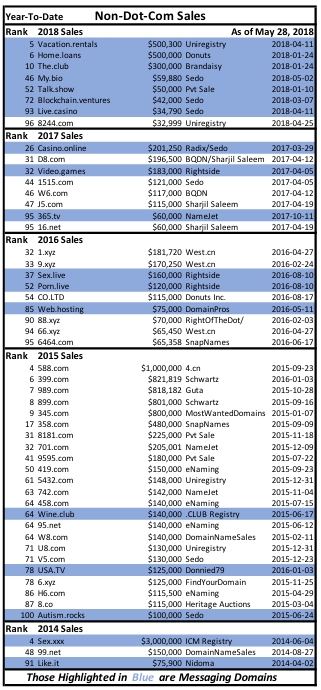It’s 1995 all over again.
Only this time there won’t be a boom and bust, just steady growth, as generic top-level domains (gTlds) go mainstream.
Non Dot Coms are domains with inherent messaging. Examples include Sporting.Events, Singles.Live, and Wine.Club. Each domain is a fully contained word phrase, rather than one with an add-on appendage to the right of the Dot, typically, one of the usual suspects: com, net, org, gov, or edu.
So, what’s going on with these new domain called gTlds or, as we like to say, “Non Dot Coms?”
If you’re looking to flip domains, these new gTlds are unlikely to sell to professional investors for a quick buck. Most domain professionals want nothing to do with anything other than classic domains, but you have to ask why. This is mainly because traditional Dot Coms are well-accepted and in high demand; Non Dot Coms are not.
In addition, holding costs are currently much higher, almost triple the renewal cost of Dot Coms, although about half their launch cost— which was $50/year when domains were first commercialized in 1995, with a 2-year minimum registrations for $100 each. The best Non Dot Coms are far pricier, yet, unlike Dot Coms, pricing has never gone down.
Widespread acceptance and speculation has yet to kick in, as it did in the late 90’s for Dot Coms. That means there’s still a window for developers and enlightened investors to buy amazing, on-point Non Dot Com messaging without competing with millions of domain speculators.
Just this year, there are strong signs that Non Dot Coms are finally beginning to take off. In the 2018 Top-100 sales-to-date, 7 are Non Dot Coms with 3 six-figure deals listed in the Top-10, according to Ron Jackson's DN Journal. You can see the trend; these sales represent a significant uptick over the last 5 years, the period when the vast majority of gTlds came on-line.
By “Non Dot Coms,” I'm focusing only on domains with meaningful, generic messaging— the "g" in gTld— excluding most country coded and numeric domains, those popular among Asians and others with image-based languages. I'm also excluding proprietary domains like .Google, .Staple, or .Walmart, which are not in play.
peaked dot coms
In contrast, while Dot Coms remain a solid investment, where’s the upside? They’re at the top of their game, so there is no objective reason to believe they will continue to grow in value. In fact, Dot Coms are no longer seen as cutting edge or even cool— certainly when the Dot Com is included in your company name, but do you know why? A Dot Com suggests you are a on-line business and that’s passé, no longer important nor stylish.
Today, it’s web services that have become essential and differentiating— what you do through the Internet— not merely being on the Internet. Put another way, everyone’s on the web; what else are you doing?
Yet, there will never be another Dot Com, just as there will never be another Broadway, Wall Street, or Hollywood. These are institutions. You need not wait another decade to know that adoption will only be modest, at best, for any one of these Non Dot Coms. We’ve already seen several follow-on domains, .me, .info, .biz, or .us., which remain obscure as domains, despite decades of availability.
So, should you get a Non Dot Com or stick with a Dot Com? Well, yes.
